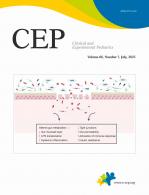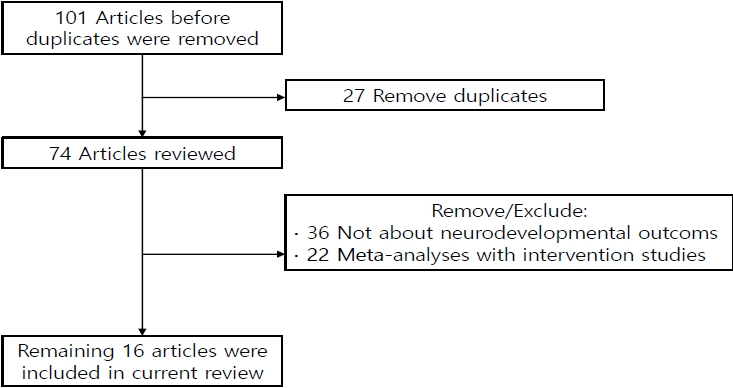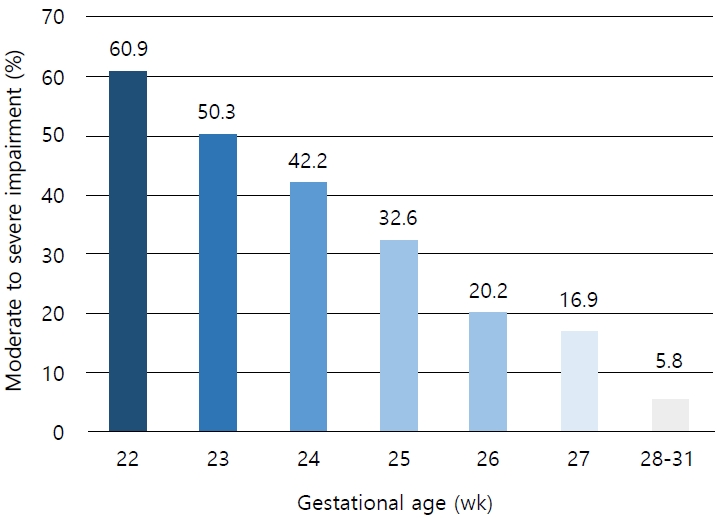Article Contents
| Clin Exp Pediatr > Volume 66(7); 2023 |
|
Abstract
Table 1.
Table 2.
| Study | Characteristics | Main results |
|---|---|---|
| Myrhaug et al. [17] (2019) | 12 Studies, GA 22–27 wk | Rates of survival without impairment were 1.2% at 22; 9.3% at 24; 40.6% at 25; 64.2% at 27 weeks. |
| Ding et al. [18] (2019) | 15 Studies, 820 GA 22–25 wk | Rates of moderate-to-severe neurodevelopmental disability were 42% at 22; 41% at 23; 32% at 24; 23% at 25 weeks. |
| Backes et al. [19] (2021) | 31 Studies, 2,226 GA 22 wk | Survival without moderate or severe impairment was 37.0%. |
| Pascal et al. [21] (2018) | 30 Studies, 10,293 VLBW or VP | Cognitive delay 16.9%, motor delay 20.6%, CP 6.8% |
| Twilhaar et al. [23] (2018) | 71 Studies, 7,752 EP or VP | 0.86 SD lower IQ compared with controls. |
| Brydges et al. [24] (2018) | 60 Studies, 6,163 VP | 0.82 SD lower on intelligence tests. |
| Twilhaar et al. [25] (2018) | 17 Studies, 2,390 Preterm (mean, 24.5–29.9 wk) | Scored lower on arithmetic, reading, spelling and more needed special education |
| Ramaswamy et al. [26] (2021) | 5 Studies, ELBW, EP | NDI prevalence was 29% for EP. |
| Maenner et al. [27] (2021) | 18 Studies, 3,366 Preterm (median, 25.1–31.3 wk) | Prevalence of ASD was 7% in preterm infants. |
| Laverty et al. [28] (2021) | 52 Studies, preterm | Odds of autism were 3.3 times higher in preterm infants. |
| Franz et al. [6] (2018) | 12 Studies, 1,787 VLBW or VP | Odds of ADHD were 3.04 times higher in preterm infants. |
| Momany et al. [29] (2018) | 88 Studies, 4,645,482 | Birth weight was associated with ADHD (r=-0.15). |
| Fitzallen et al. [30] (2021) | 11 Studies, Preterm 1294 (anxiety), 777 (depressive) | Odds of anxiety were 2.17 times higher in preterm infants. |
| Fernández de Gamarra-Oca et al. [31] (2021) | 16 studies, MLPT | Greater odds for any psychiatric disorders |
| Allotey et al. [32] (2018) | 74 Studies, 64,601 children | Late preterm infants had lower IQ and higher odds of ADHD. |
| Sacchi et al. [34] (2020) | 60 Studies, 52,822 children | IUGR and SGA had significantly poorer cognitive outcomes. |
GA, gestational age; VLBW, very low birth weight; VP, very preterm infants; SD, standard deviation; CP, erebral palsy; EP, extremely preterm; NDI, neurodevelopmental impairment; ASD, autism spectrum disorder; ADHD, attention deficit hyperactivity disorder; ELBW, extremely low birth weight; MLPT, moderate- to late-preterm infants; IQ, intelligent quotient; IUGR, intrauterine growth retardation; SGA, small for gestational age.
Table 3.
| Study | Characteristics | Data | Main results |
|---|---|---|---|
| Song et al. [16] (2022) | 2,143,652 children at age 4–10 years | NHIS | VLBW and LBW had higher odds of ADHD and ASD. |
| Cho et al. [37] (2021) | 17,189 twins ≥34 wk | NHIS | Late preterm twins had a higher risk of neurodevelopmental delay (HR, 1.14; 95% CI, 1.07–1.21). |
| Jin et al. [36] (2020) | 37 MLPT | Hospital | MLPT infants had risks of developing borderline intelligence functioning and attention problems at early school age. |
| Youn et al. [38] (2018) | 2,660 VLBW | KNN | Prevalence of cerebral palsy 6.2%–6.6%, blindness 0.2%–0.3%, and hearing loss 0.8-1.9% in VLBW infants |
| Han et al. [39] (2022) | 2,961 VLBW | NHIS | Periventricular leukomalacia, growth restriction in HC and height were risk factors for developmental delay. |
| Song et al. [40] (2021) | 122 VP or VLBW | Hospital | HC growth between PMA 35 weeks and 4 months CA was associated with BSID III scores. |
| Cho et al. [41] (2021) | 90 SGA VLBW | Hospital | HC growth between birth and PMA 35 weeks and catch-up at 4 months CA were associated with development. |
| Kim et al. [42] (2021) | 56 VP or VLBW | Hospital | IQ was correlated with postnatal weight gain in the NICU. |
| Bae et al. [43] (2021) | 182 VLBW | Hospital | Moderate to severe BPD and severe ROP were associated with adverse neurodevelopmental outcomes of VLBW infants without severe brain injury. |
| Ahn et al. [44] (2022) | 2,132 VLBW | KNN | Motor and cognitive delays were associated with ROP. |
| Shim et al. [45] (2021) | 2,098 VLBW | KNN | Late-onset sepsis was associated with cognitive delay. |
| Kim et al. [46] (2018) | 166 VLBW | Hospital | Hypotension was associated with cognitive and language delay. |
| Youn et al. [47] (2017) | 191 VLBW | Hospital | Early hydrocortisone exposure did not increase the risk for poor developmental outcomes. |
| Sung et al. [48] (2019) | 7,885 VLBW | KNN | Surgeries increased the risk of neurodevelopmental impairment. |
| Youn et al. [49] (2019) | 142 VLBW | Hospital | Surgical ligation of PDA did not increase risk of poor neurodevelopmental outcomes. |
| Youn et al. [50] (2021) | 138 VP | 3 Hospitals | Intervention program showed no positive effect on neurodevelopmental outcomes. |
NHIS, National Health Insurance Service; VLBW, very low birth weight; LBW, low birth weight infants; ADHD, attention deficit hyperactivity disorder; ASD, autism spectrum disorder; HR, hazard ratio; CI, confidence interval; MLPT, moderate- to late-preterm infants; KNN, Korean Neonatal Network; HC, head circumference; PMA, postmenstrual age; CA, corrected age; BSID III, The Bayley Scales of Infant and Toddler Development, third edition; SGA, small for gestational age; IQ, intelligent quotient; NICU, neonatal intensive care unit; BPD, bronchopulmonary dysplasia; ROP, retinopathy of prematurity; PDA, patent ductus arteriosus; VP, very preterm.








 PDF Links
PDF Links PubReader
PubReader ePub Link
ePub Link PubMed
PubMed Download Citation
Download Citation


